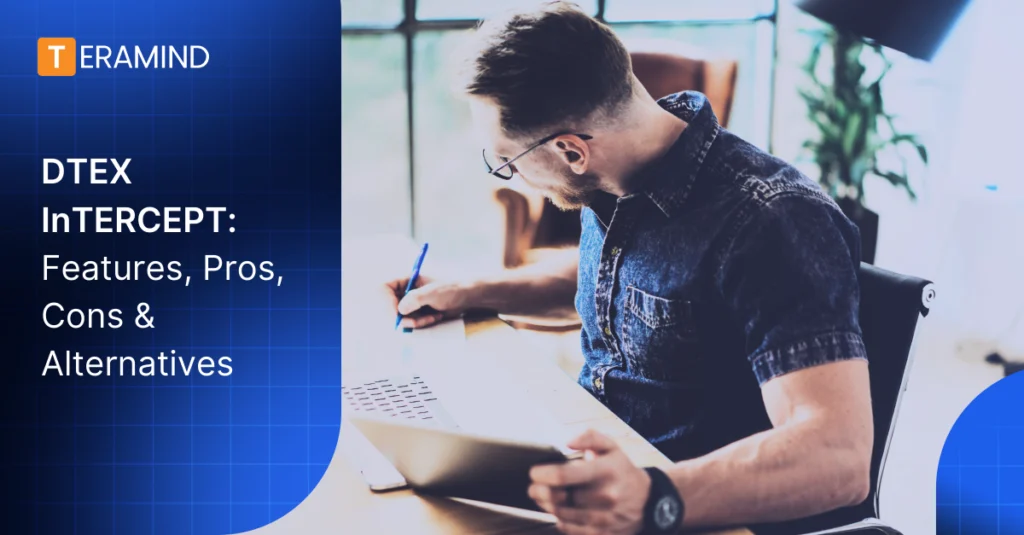Insider risk management solutions have become essential for organizations seeking to protect sensitive data, prevent insider threats, and ensure compliance. DTEX iNTERCEPT is a powerful tool in this market, primarily addressing the need for comprehensive insider threat detection and data loss prevention. While it offers robust behavioral analytics and risk assessment features, some users may find the software doesn’t meet their needs.
What is DTEX iNTERCEPT?
DTEX iNTERCEPT is an insider risk management and behavioral data loss prevention solution. It consolidates the essential elements of endpoint DLP, UBA, UAM, and digital forensics into a single, lightweight platform capable of extending protection to thousands of endpoints and servers without impacting user productivity and endpoint performance. By combining AI and ML with behavioral indicators, DTEX iNTERCEPT enables proactive insider risk management at scale while maintaining employees’ privacy and minimizing impact on network performance.
Pros and Cons of DTEX iNTERCEPT
| Pros | Cons |
| Advanced behavioral analytics | Limited monitoring channels |
| Comprehensive data collection | Limitations in alert management |
| Customizable risk scoring | Steep learning curve for administrators |
| Detailed forensic investigation capabilities | Limited integration with third-party tools |
| Real-time alerting and reporting | Potential performance impact on endpoints |
| Seamless cloud and on-premise deployment options | Higher cost compared to some competitors |
Key Features of DTEX iNTERCEPT
User Behavior Analytics
DTEX iNTERCEPT leverages advanced behavioral analytics to identify potential insider threats and anomalous user activities. The system employs sophisticated pattern recognition algorithms to establish baseline behaviors for individuals and groups within the organization. By continuously monitoring user actions, applications accessed, and data handling patterns, it can quickly identify deviations that might indicate potential security risks or policy violations. The platform’s behavioral analytics engine considers multiple factors including time of access, location, device usage, and interaction patterns with sensitive data to build comprehensive user profiles.
Key functionalities:
- Machine learning algorithms: Continuously analyze user behavior patterns to establish baselines and detect deviations.
- Risk scoring: Assigns risk scores to users based on their activities and potential threat level.
- Behavioral fingerprinting: Creates unique profiles for each user to identify unauthorized access or account sharing.
Disadvantages
While the behavioral analytics feature is powerful, it may generate false positives in dynamic work environments where user roles and responsibilities frequently change. Additionally, the system requires a significant amount of historical data to establish accurate baselines, which can be challenging for newly implemented deployments.
Data Loss Prevention (DLP)
DTEX iNTERCEPT offers comprehensive DLP capabilities to protect sensitive information from unauthorized access or exfiltration. The solution combines traditional content-based DLP with contextual awareness to provide more accurate and effective data protection.
It monitors all potential data egress points, including email, cloud storage, USB devices, and printing activities, while considering the context of user behavior and organizational policies. The system can identify and protect both structured and unstructured sensitive data, including intellectual property, customer information, and regulated data types.
Key functionalities:
- Content inspection: Scans files and communications for sensitive data patterns.
- Policy enforcement: Applies customizable rules to prevent data leakage across various channels.
- Endpoint monitoring: Tracks file transfers, clipboard usage, and printing activities.
Disadvantages
The DLP feature may occasionally impact system performance, especially when scanning large volumes of data. Furthermore, creating and fine-tuning DLP policies can be time-consuming and may require ongoing adjustments to balance security with productivity.
Forensic Investigation
DTEX iNTERCEPT provides detailed forensic investigation tools to analyze security incidents and user activities. The platform maintains a comprehensive audit trail of user actions, system events, and data movements, allowing security teams to conduct thorough investigations when incidents occur.
The forensic capabilities include advanced search functions, timeline analysis, and detailed metadata examination, enabling investigators to quickly piece together the sequence of events leading to a security incident. The system also maintains chain of custody documentation and provides court-admissible evidence when needed for legal proceedings.
Key functionalities:
- Activity playback: Reconstructs user sessions to visualize the sequence of events leading to an incident.
- Metadata collection: Gathers extensive metadata to provide context for investigations.
- Customizable reporting: Generates detailed reports for compliance and auditing purposes.
Disadvantages
The wealth of data collected for forensic investigations may lead to storage challenges, especially for organizations with limited infrastructure. Additionally, the complexity of the investigation tools may require specialized training for security personnel to effectively utilize all features.
Real-time Alerting
DTEX iNTERCEPT offers real-time alerting capabilities to notify security teams of potential threats or policy violations. The alerting system integrates with the behavioral analytics engine to provide context-aware notifications that help security teams prioritize their response efforts.
It features machine learning-based alert correlation to reduce false positives and identify complex attack patterns that might not be apparent when examining individual alerts in isolation. The platform also provides flexible alert routing and escalation paths to ensure that critical security events receive immediate attention from the appropriate personnel.
Key functionalities:
- Customizable alert thresholds: Allows administrators to set specific triggers for different types of activities.
- Multi-channel notifications: Sends alerts via email, SMS, or integration with SIEM systems.
- Alert prioritization: Categorizes alerts based on severity and risk level.
Disadvantages
The real-time alerting system may generate a high volume of notifications in large organizations, potentially leading to alert fatigue among security personnel. Fine-tuning alert thresholds to reduce false positives while maintaining effectiveness can be an ongoing challenge.
Endpoint Monitoring
DTEX iNTERCEPT provides comprehensive endpoint monitoring to track user activities across various devices and platforms. The solution deploys lightweight agents that monitor endpoint activity while minimizing performance impact. It captures detailed telemetry about user behavior, application usage, and data handling patterns while maintaining user privacy through configurable data collection policies.
The endpoint monitoring capability extends to both corporate-managed and BYOD devices, providing consistent visibility across the entire endpoint ecosystem while respecting privacy requirements and local regulations.
Key functionalities:
- Cross-platform support: Monitors Windows, macOS, and Linux endpoints.
- Application usage tracking: Records application access and usage patterns.
- Network activity monitoring: Tracks inbound and outbound network connections.
Disadvantages
The extensive endpoint monitoring capabilities may raise concerns about resource utilization on user devices, potentially impacting performance. Additionally, deploying and maintaining agents across a diverse endpoint ecosystem can be challenging for IT teams.
Where Teramind Excels
Let’s compare DTEX to Teramind — where you can decide what matters.
- User-friendly interface: Teramind offers a more intuitive and visually appealing dashboard, making it easier for non-technical users to navigate and understand.
- Productivity monitoring: Teramind provides more robust features for tracking employee productivity (while respecting employee privacy), including time tracking and project management integrations.
- Screen recording: Teramind’s screen recording capabilities are more advanced, offering high-quality video capture with minimal impact on system resources.
- Customizable reports: Teramind offers a wider range of pre-built report templates and more flexible options for creating custom reports.
- Remote desktop control: Teramind includes remote desktop control functionality, allowing administrators to provide direct assistance to users when needed.
Why You Should Consider Teramind
Advanced OCR and Content Analysis
Teramind’s Optical Character Recognition (OCR) technology allows for content analysis of both structured and unstructured data, including images and PDFs. This feature enables more comprehensive data protection and insider threat detection by identifying sensitive information in various formats.
The content analysis capabilities extend to real-time monitoring of on-screen content, allowing organizations to enforce policies even when users attempt to circumvent traditional DLP measures. This level of granularity in content inspection provides a significant advantage in preventing data leakage and ensuring compliance.
User Activity Video Recording
Teramind offers high-quality video recording of user activities, providing a visual context for security investigations and audits. This feature goes beyond simple screen captures, offering a full video playback of user sessions with minimal impact on system performance.
The video recording functionality is particularly valuable for industries with strict compliance requirements, as it provides irrefutable evidence of user actions. Additionally, the ability to quickly search and retrieve specific video segments based on various criteria streamlines the investigation process and reduces response times to potential security incidents.
Automated User Behavior Analytics
Teramind’s User Behavior Analytics (UBA) feature leverages machine learning algorithms to detect and respond to anomalous user behaviors automatically. This system continuously learns from user activities, adapting to changing work patterns and reducing false positives over time.
The automated UBA capabilities include risk scoring, predictive analytics, and automated response actions. This level of automation allows organizations to proactively discover insider threat indicators and policy violations without requiring constant manual monitoring by security teams.
Why You Should Choose Teramind
- Comprehensive monitoring solution: Teramind offers a more complete suite of monitoring tools, combining productivity tracking, insider threat detection, and compliance management in a single platform.
- Ease of use: With its intuitive interface and extensive documentation, Teramind provides a shorter learning curve for administrators and end-users alike, reducing implementation time and training costs.
- Scalability: Teramind’s architecture is designed to scale efficiently, making it suitable for both small businesses and large enterprises without compromising performance or functionality.
- Continuous innovation: Teramind consistently introduces new features and improvements based on customer feedback and emerging industry trends like artificial intelligence (AI), ensuring organizations stay ahead of evolving security challenges.


